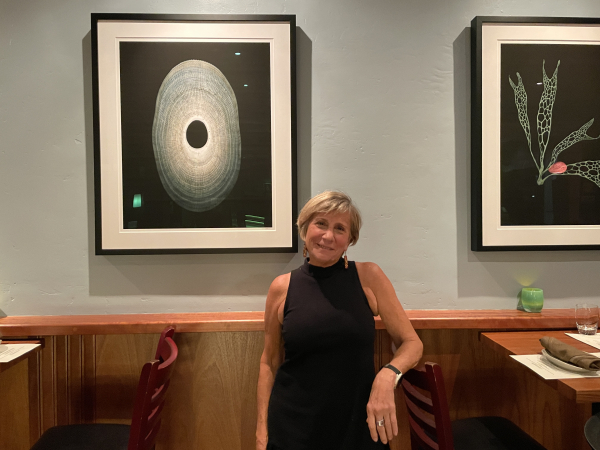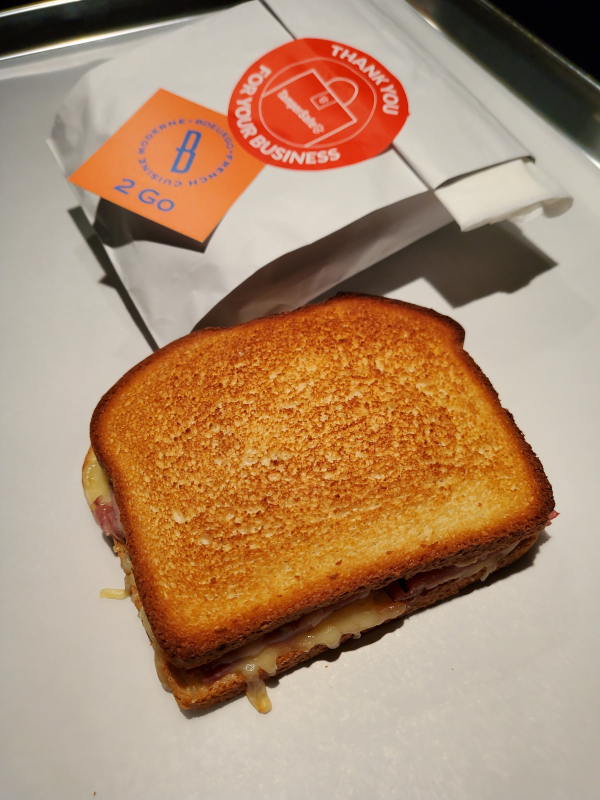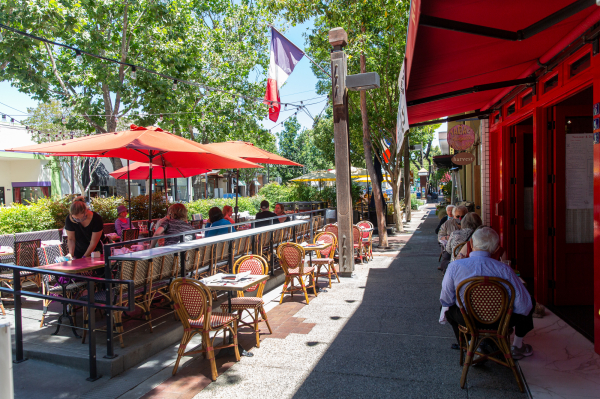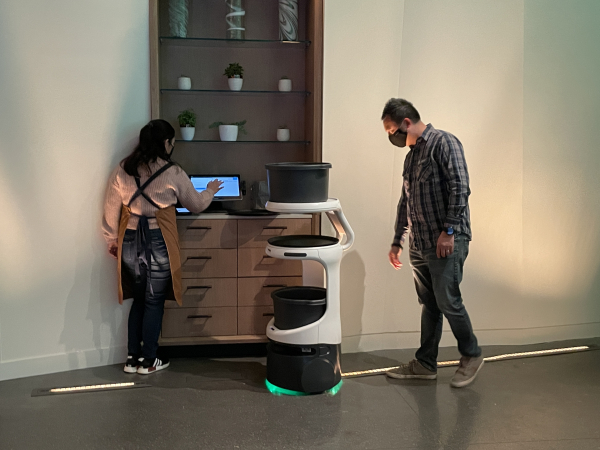It's Friday evening in Menlo Park. Bells are ringing, marking 5 o'clock at a church just down the road. At Flea Street, the team is finishing their family meal before guests arrive. Jesse Cool energetically whisks around the restaurant she opened 41 years ago.
The stainless steel Blodgett oven in the kitchen has been in constant use since then, but there's a lot that's new, recently installed to adapt with the COVID-19 pandemic. With the help of a restaurant relief grant, Cool did a renovation: There are now high-tech air filters, and new doors and sliding windows for fresh air. The blockades outside that once encased straw bales and "barn"-style dining have given way to a new, cozy outdoor dining room raised on a wooden platform.

"It's thoughtful dining." Flea Street founder Jesse Cool at the newly renovated restaurant in Menlo Park. Photo by Sara Hayden.
"Do you remember when we used to have to stand by the tables and iron out the tablecloths?" Cool reminisced. That's unthinkable now. Wood tables are on full display, tablecloth-free for easier sanitization.
Instead of a fleet of staff catering to each table, there are service stands where guests can help themselves to take and leave what they need.
The team has replaced stemmed glassware with stemless to make the journey over concrete easier for outdoor dining.
"Everything's beautiful, but it's different," Cool says.
These physical changes are priceless in an attempt to preserve everyone's health during the pandemic. There have been less visible but equally significant changes too — in operations, attitudes and mindsets.
"What's the future of fine dining?" I want to know. Cool corrects me: "This isn't fine dining," Cool says. "This is 'thoughtful dining.'"
Imagining the possibilities of what "thoughtful dining" entails, I have faith that the future of dining — fine, casual and otherwise — is full of hope.
Over the past several months, I reviewed data on industry trends and spoke with movers and shakers who've helped define the Peninsula food landscape over the years about predictions for what's to come. I know it's a loaded question, one that's impossible to answer.
"If I had that crystal ball, I don't know if I would be in the restaurant business," Manresa executive chef David Kinch says.
But among the uncertainty, what I do hear is revealing. For ROOH's chief operating officer Anu Bhambri, there's constant change. "Hopefully things will come back soon. But I don't know what the new normal is," Bhambri says. "The definition of normal keeps changing."
As the changes come, these are some things that will likely stay a while.
Face masks and proof of vaccination remain essential
These days when going out to eat, it's important not only to check a restaurant's menu, but also a restaurant's COVID-19 guidance as cases of the omicron variant have spiked in the Bay Area.
California recently issued a mandate that requires everyone to wear a mask in indoor public spaces through Jan. 15. Santa Clara County also issued a health order recommending that everyone who's eligible get vaccinated and boosted, and that restaurants and bars require patrons to be up-to-date on their vaccination and show proof upon entry.
Restaurateur Keith Richardson of Keith's Chicken-N-Waffles advises that businesses continue to take precautions and follow government guidelines.
"As restaurateurs, we have to make sure we cover the COVID protocol and sanitation to make people feel comfortable in their dining experience," Richardson says.
Small businesses continue to be vital
In San Mateo County, the U.S. Census Bureau reports that small business is big business: More than 97% of employers had fewer than 100 employees in 2018.
In 2021, local leaders made moves to support these critical contributors to the economy's recovery during the pandemic. The San Mateo County Board of Supervisors approved new grants for small businesses, more multilingual resources, cultural outreach and legalization of home food businesses.
Dishing up osso bucco, crepes, cake with white chocolate and lemon curd lava and more, entrepreneurs across the Peninsula have since received permits to use their home kitchens for retail purposes.
Cross-cultural innovation drives Peninsula cuisine and conversation

Smoked sai oua and papaya salad from Sandy's World of Eats at Breakwater Barbecue. Photo by Sara Hayden.
These are just a few businesses that have recently emerged in the Peninsula's food and drink scene that are evolving flavors and techniques:
In Belmont, Eats Meets West Bowls has Indian curries and Panamanian salsas on the menu. At Sushinaloa in Redwood City, the team uses chipotle, chiltepin and jalapeño and other flavors from the Mexican state of Sinaloa to add spice to sushi. In Menlo Park, dishes at The Mandarin are influenced by Cantonese, Szechuanese, Japanese cuisine and more. Brewing With Brothas is putting their own twist on Belgian and German beers in East Palo Alto. On the Coastside, Sandy's World of Eats and Breakwater Barbecue have made Laotian sausages with southern barbecue techniques.
As they push culinary styles forward, one essential skill that these entrepreneurs share is storytelling. To introduce their concepts to customers, they foster connection through social media, menu writing and more.
San Mateo's chef Martin Yan has branched out from television to social media, promoting the transition from cooking techniques that depend on fossil fuels to induction cooktops.
At Warung Siska in Redwood City, the team shares not only Indonesian cuisine, but also culture and language. On the website, they include phrases in Bahasa.
"I think adding those phrases really helps to make the experience more in-depth … Having those words on the website was a way to expand the dining experience for our non-Indonesian diners as well," principal partner Anne Le Ziblatt said in a previous interview.
At Aurum in Los Altos, chef Manish Tyagi writes menus that tell a story about his influences as someone who grew up in northern India and professionally trained in French and Italian cuisines.
On his dish "I'm Not Pasta - Spinach & Paneer Lasagne" (which gained renown on the reality show "Beat Bobby Flay"), Tyagi says, "The representation is Italian, but there is nothing Italian except using that style or technique. Everything is Indian after that."
For the Mr. Potato - Potato Spiral Chaat, Tyagi says, "Here I'm using a Korean technique to cut the potatoes to make a tornado potato in a spiral and using the same method the same way we make our chaats in India."
And for the Comfy - Arancini dish, Tyagi says, "I call it arancini so I can connect with the people here in California … Keeping the names simple is a way to create lightness among the menu and the guests so they can start building a connection with these foods even before it reaches them."
With different interpretations of these dishes, Tyagi hopes guests take away a new appreciation for the varied cuisines of his country: "Indian food has much more to offer," Tyagi says.
Fine dining flexes toward casual

B Deux Go, by the restaurateurs behind Baumé, offers sandwiches to-go. Photo courtesy of B Deux Go.
Fine-dining establishments had to rethink business models that once heavily depended on what could be experienced in person — attentive service throughout the meal, the careful orchestration and timing of multiple courses, crisp tablecloths, the luxury price points. These historic hallmarks of "fine" don't readily translate toward the takeout model that local ordinances required at the start of the pandemic.
Along with other sectors of the food and beverage industry, fine dining suffered during the pandemic. Operators reported that their off-premise sales accounted for less than 20% of their on-premise sales. More than 60% said that their staffing levels were more than 20% below normal.
The Bacchus Group, which counts the Michelin-starred Village Pub, Selby's and Spruce among its restaurants, experienced this. Founding partner Tim Stannard recalls the pain of being presented with laying off staff.
The team met, and decided they'd try a limited run of three-course meals delivered via DoorDash. They called it the "family meal" and sold out in 40 minutes. Could the more casual meal service keep the team together? At the peak of the program, the Bacchus Group opened all its kitchens to support demand.
"It was a strange thing. I never thought I'd be cooking spaghetti and meatballs and chocolate pudding, but here we are," Stannard says.
After the onset of the pandemic, three-Michelin-starred Manresa offered a takeout menu for more than a year.
"A lot of our menus weren't expensive menus, they were everyday menus for everybody on a Tuesday or Thursday — not just a special occasion," executive chef David Kinch says. "I think people appreciated that. People were coming on a regular basis."
Other fine-dining restaurateurs are experimenting with casual angles too, both out of necessity and a desire for more creative freedom.
Meichih and Michael Kim, formerly co-chefs at Palo Alto's fine-dining destination Maum, launched B?o Bèi the fall. At State Street Market in Los Altos, they serve $9.50 spicy pork belly and fried shrimp bao and $15 dan dan noodles. For them, the potential for community fostered by a food hall environment was the main draw.
“Given how the pandemic forced us to stay indoors, I think we lost touch with connecting, and that feeling of being around others,” Meichih Kim said prior to B?o Bèi's opening.
Chad and Monica Kaneshiro previously left the fine-dining world to open brunch hotspot Morning Wood in 2017. After closing in April, they relaunched in their San Bruno space in the summer with the Diamond Head General Store, offering a counter with plate lunches to go and a retail space with pantry goods.
Bruno and Christie Chemel recently spun out a new concept, separate from their restaurant Baumé that maintained two Michelin stars between 2011 and 2019. B Deux Go (also known as "B 2 Go" — gotta love the pun!) serves sandwiches priced at $14.98 from the door of the same kitchen where they prepare Baumé's multicourse menu that runs hundreds of dollars per person. On B 2 Go's menu, the croque-style sandwich's béchamel sauce is simply noted as "white sauce."
"The concept is honest sandwiches for honest people," Chemel said in a previous interview. "There's nothing fancy."
There are still plenty of opportunities for luxurious tablecloths and multicourse dinners, but because of these new, more flexible approaches, guests who might not have had access to "fine dining" can now experience very fine food because of them.
Still, fine dining is here to stay, Kinch says.
"I think that what fine dining is truly all about is to offer a truly stellar experience. Fine dining is not going to go away. There's always going to be people who demand this type of experience, but there are things that are going to have to change. We're starting to see that now," Kinch says.
"There's a certain degree of casualness coming into it, and a little bit more flexibility with people's dietary concerns."
Diners get social — with dogs

People sit for lunch at Bistro Vida's outdoor dining area in downtown Menlo Park. Photo by Magali Gauthier.
On March 16, 2020, San Mateo County instituted an ordinance to "shelter in place" — urging people to isolate themselves as much as possible following a state of emergency declared by Gov. Gavin Newsom.
Just as soon as the new restaurant ROOH Palo Alto had opened, it had to close.
"When we left, we were like, 'It's a couple of weeks. We'll be back soon,'" Anu Bhambri remembers. "And it went on and on."
Now, people are hungry for restaurants not only for their food, but for the connections they foster.
"I strongly feel like restaurants are an essential part of our life. We all go out, connect with people, connect with family," Bhambri says. "That social aspect of life is so important. We are social animals."
Recently, the ROOH Palo Alto team has stocked up on blankets and other outdoor dining amenities to keep guests warm during the winter, ramping up for an increased demand in on-site dining.
In the first half of October this year, U.S. reservations for December were up more than 40% compared to the same time periods in both 2018 and 2019, according to data from OpenTable. The data shows a bump in the number of reservations for more intimate parties, rather than big gatherings.
"Now that last year has happened, people have realized there are things we used to take for granted," Bhambri says. "Now people appreciate it more."
While some people are eager to get out, they're also reluctant to leave their pets behind. Many people turned to animals for support during the pandemic. In a National Geographic survey, 87% of respondents indicated that their animal helped them cope with the pandemic.
Ali El Safy's Bistro Vida has long taken inspiration from France in multiple ways, from the decor to the open-air markets. Now, there's also beautiful outdoor spaces to enjoy leisurely meals with friends and family — including dogs.
"We become dog-friendly," says El Safy, who has a pitbull he describes as a "big baby." "Everybody in the pandemic, they get dogs. Now everybody wants to go with their dog. It's the whole family — (the dog) is part of the family."
Teams prioritize well-being and care for the community and themselves
In August, the New York Times reported that San Mateo County experienced the largest increase in food stamp enrollment in the state since January 2020. There was a more than 40% increase in the number of people depending on the CalFresh food benefit program.
As the need for meals rose, dozens of local restaurants donated. As one example, 84 restaurants participated in the Great Plates program and served 2.7 million meals to 4,689 clients in San Mateo County. Federal funding for that program ended in the summer, but the need for meals remains.
"Those who have (must) take care of those who don't have," Flea Street's Jesse Cool says.
At the same time, restaurateurs are working on avoiding burnout for themselves and their teams. Creating a supportive culture is essential.
Cool says that the pandemic brought to light industry issues that had already been glaring.
"(That) was justice in our industry, how many dysfunctions and inequality (and) unhealthy lifestyles there were," Cool says.
It's essential to ensure that people are paid well and have sufficient time off, she says. The Flea Street team will be on break Jan. 1 through Jan. 10.
"That's my job — how to figure out how to give a better lifestyle to the people who take care of others and who take care of me and the business," Cool says. "The customer comes last. If we take care of where the food comes from, and the people who wash the dishes and the people who cook, then they will take care of the guest."
Flea Street only serves dinner instead of three meals a day, giving the team more time to recharge between meal services. The restaurant also closes twice a year. Cool also advocates for more equal compensation between kitchen and service staff — what Cool calls "Heart of House" instead of "back of house" and "front of house."
"We simply still believe that both service and production are a much more equal part of a guest's meal," Cool says.
At a time when more than 3 out of 5 restaurant workers have reported abuse or disrespect from customers — from refusing to follow pandemic precautions to other forms of harassment — restaurant leaders must find ways to support their staff.
"Those who gave our staff a really hard time, sometimes I'd just have to say to them, 'It's OK if you don't eat here,'" Cool says.
Humans team up, and sometimes robots too

Roger Bar and Restaurant food and beverages director Jacky Li says the staff uses it as an amenity to help return dishes from the dining room to the kitchen. Photo by Sara Hayden.
Nationally, 4 out of 5 restaurateurs say recruiting and retention is their greatest challenge. This hits close to home: According to Tony Han of Tai Pan in Palo Alto, just about every Bay Area restaurant in an industry group of 36 reported having a staffing shortage.
“A lot of these restaurants are on a skeleton crew right now," says Wyatt Fields of Breakwater Barbecue in El Granada. "You cannot find anyone to work right now."
Restaurateurs have been devising different ways to handle this, including offering more competitive incentives and flexibility, sharing staff with other restaurants or pivoting operations to make the most of their teams' bandwidth.
Dino Tekdemir closed Anatolian Kitchen and has plans to reopen as Naschmarkt Palo Alto — a sister restaurant to a location in Campbell. The idea is to bring talent from the Campbell location to the Palo Alto one, so the existing team can use their existing skills, without having to retrain.
The team at Roger Bar and Restaurant in Mountain View has been experimenting with using robots, from Redwood City's Bear Robotics. The team has programmed robots to return dishes to the kitchen. That helps free up the human team to focus on other guest interactions.
"What we don't want for the guest to feel is they're not getting any service," food and beverages director Jacky Li says.
In that regard, robots are no substitute for humans. Restaurants still have a strong demand for more people.
"If we play this out, we have to entice people to work for us, which means we have to raise the wages," Han says. "Now we're essentially in a very competitive state, with our fellow restaurant owners trying to secure these helps. A lot of the skill sets, we're looking for the same people, but we have to incentivize this. The cost is going to snowball and be reflected to the customer."
As the labor shortage continues, Fields suggests that restaurant guests stay in respectful communication with staff about what they need, and have compassion.
"We’re only human back there," Fields says.
Looking forward
The pandemic isn't over, and new guidance emerges daily. It looks like the only certainty is change.
"We'll need to adapt to a new set of scenarios and keep changing, keep learning. That's the only way going forward," ROOH's Bhambri says.
In the meantime, the pandemic has reset values as people seek support and safe reconnection.
"Something happened. We (had) lost the value of food," Flea Street's Cool says. "A lot of us are weaving our way out …The kindness I feel now again, the collaboration, the respect is really wonderful. And of course you taste that in food."



